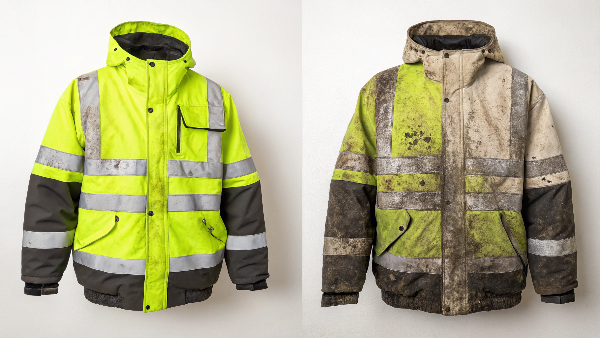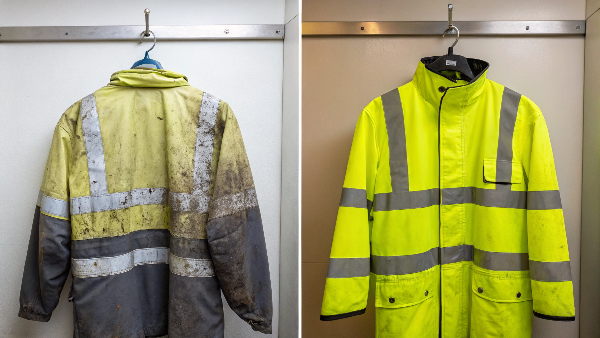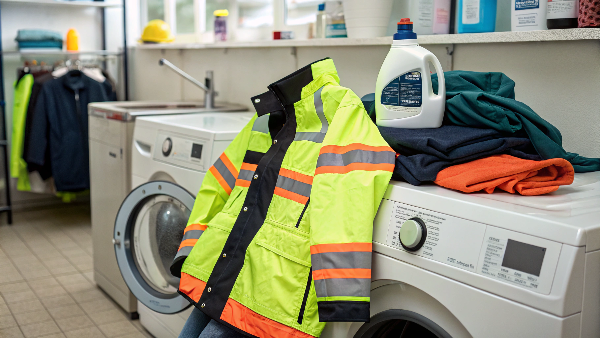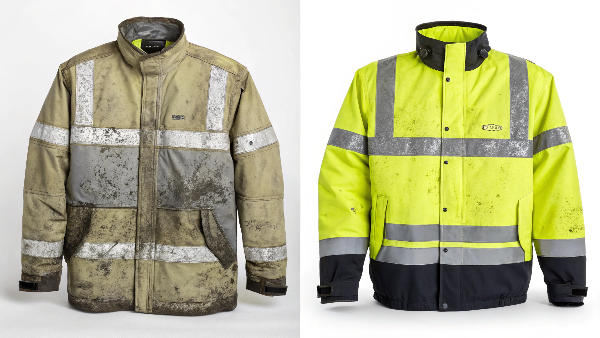Your hi-vis jacket is losing its glow. Dirt and grime build up, making you less visible and unsafe. Don't let neglect ruin your gear or compromise your personal safety.
Wash your hi-vis waterproof jacket when it's visibly dirty, smells, or if water no longer beads up on the surface. For heavy daily use, wash it every 4-6 weeks. For light or occasional use, once or twice a season is often enough to maintain performance.

Keeping your gear clean is about more than just looks; it's a critical part of your safety system. If you've ever wondered about the right way to care for your jacket without damaging its special properties, you're in the right place. We'll break down everything you need to know, from washing frequency to replacement schedules. This guide will help you protect your investment and, more importantly, yourself. Let's dive in.
How many times can you wash a hi-vis jacket?
You worry that washing your jacket will fade its brightness. It seems like frequent washing would wear out the reflective tapes1 and fabric. You need to know the safe limit.
Most certified hi-vis jackets can be washed between 25 and 50 times before losing their effectiveness. This number is tested according to standards like EN ISO 204712. Always check the manufacturer's care label for the specific wash cycle limit3 for your garment.

The wash limit on a hi-vis jacket isn't just a suggestion; it's tied directly to safety standards4. Certifications like EN ISO 20471 and ANSI/ISEA 107 mandate that a garment maintains specific levels of fluorescence (daytime visibility) and retro-reflectivity (nighttime visibility) after a certain number of washes. Once you exceed that number, the jacket may no longer be compliant, even if it looks okay. At Vissafety, we test our fabrics in our own lab to ensure they meet these global standards. For one of my long-term clients, Danny Cheng, who distributes PPE in North America, this is a major concern. His customers in construction and logistics need gear that can be washed frequently without losing its safety rating. We work together to develop products that not only meet but exceed the minimum wash cycles, providing clear guidance on the care label so his customers know exactly how to maintain their gear for maximum safety and lifespan.
| Feature | Standard Requirement | Impact of Exceeding Wash Limit |
|---|---|---|
| Fluorescence | Must maintain a specific color and brightness level. | Color fades, making you less visible in daylight. |
| Retro-reflectivity | Reflective tape must return a minimum amount of light. | Tape degrades and cracks, reducing nighttime visibility. |
| Overall Compliance | Garment must meet standards after specified washes. | Garment is no longer considered certified safety apparel. |
How do you clean a high-visibility jacket1?
You throw your regular work clothes in the wash without a second thought. But your hi-vis jacket is different. Using the wrong settings or detergents can strip its protective features permanently.
First, always check the care label. Generally, you should close all zippers and flaps, then wash it on a gentle cycle with cold or warm water (under 40°C/104°F). Use a mild, non-biological detergent2. Never use bleach or fabric softeners.

Proper cleaning is a simple process, but every step is important for preserving the special materials in your jacket. Neglecting these steps can damage both the high-visibility colors and the waterproof membrane, rendering your expensive gear ineffective. I always follow a three-part process to ensure the best results.
1. Pre-Wash Preparation
Before the jacket even goes into the machine, a little prep work goes a long way. First, brush off any loose mud or debris with a soft brush. For tough stains like grease, apply a small amount of diluted mild detergent directly to the spot and gently rub it in. Most importantly, close all zippers, buttons, and Velcro flaps. This prevents them from snagging on the fabric or damaging the inside of your washing machine.
2. Washing and Drying
The choices you make here are critical. Using the wrong products can cause irreversible damage.
| Action | Do | Don't |
|---|---|---|
| Machine Settings | Use a gentle or delicate cycle with a low spin. | Use high heat or aggressive spin cycles. |
| Detergent | Use a mild, non-biological liquid detergent. | Use powdered detergents, bleach, or fabric softeners. |
| Drying | Hang to air dry away from direct sun, or tumble dry on low. | Wring out the jacket or dry on a high heat setting. |
Bleach and harsh detergents will quickly fade the fluorescent yellow or orange dyes. Fabric softeners clog the pores of waterproof, breathable membranes like Gore-Tex, which stops them from working correctly.
3. Reactivating Water Repellency
If you notice water is soaking into your jacket instead of beading up, the Durable Water Repellent (DWR) coating3 needs a refresh. After washing, a short 15-20 minute tumble dry on a low heat setting can often reactivate the DWR. If that doesn't work, you can apply a spray-on DWR treatment, which you can find at most outdoor gear stores.
How often should you replace hi-vis clothing?
Your favorite hi-vis jacket has seen better days. It's faded, and the reflective strips are cracked. But is it just worn out, or is it actually unsafe to use?
You must replace hi-vis clothing when it is visibly faded, torn, permanently soiled, or when the reflective tape is cracked or missing. There is no set expiry date; its life depends on use and care. Regular inspection is essential for safety.

High-visibility clothing does not have a calendar "best before" date like food does. Instead, it has a functional lifespan. Its effectiveness ends when it can no longer do its job of making you seen. For my clients who manage large teams, I always recommend creating a simple inspection policy. This removes guesswork and ensures every worker stays protected. A jacket worn daily on a gritty construction site might only last six months, while a jacket worn by a supervisor in a cleaner environment could last for several years. The key is to know what to look for. During your routine checks, ask yourself these questions.
| Inspection Checklist | Looks Good (Keep Using) | Time to Replace |
|---|---|---|
| Background Color | Bright and fluorescent. | Faded, dull, or sun-bleached. |
| Reflective Tape | Silver, intact, and reflects light brightly. | Cracked, peeling, missing sections, or darkened. |
| Cleanliness | Clean or can be washed clean. | Permanently stained with grease, tar, or dirt. |
| Physical Condition | No major rips, tears, or holes. | Has large tears, frayed seams, or broken zippers. |
If your jacket fails any of these checks, it's time for a replacement. A faded or damaged jacket gives a false sense of security and puts you at risk.
Conclusion
Properly washing and inspecting your hi-vis jacket is crucial for safety. Following these simple steps extends the garment's life, maintains its protective features, and keeps you visible.
-
Learn about reflective tapes to understand their role in enhancing safety during low visibility conditions. ↩ ↩
-
Understanding EN ISO 20471 helps ensure your hi-vis jacket meets safety standards for visibility. ↩ ↩
-
Knowing the wash cycle limit ensures your hi-vis jacket maintains its effectiveness and safety over time. ↩ ↩
-
Exploring safety standards will help you choose compliant and effective hi-vis apparel for your needs. ↩



